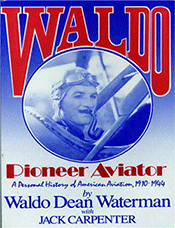 |
Waterman, Waldo D. (with Jack Carpenter). 1988. WALDO: Pioneer Aviator: A Personal History of American Aviation, 1910-1944. Arsdalen, Bosch & Co. Laguna Niguel, CA. 492pp.
---o0o---
THANK YOU!
YOUR PURCHASE OF THESE BOOKS SUPPORTS THE WEB SITES THAT BRING TO YOU THE HISTORY BEHIND OLD AIRFIELD REGISTERS
Your copy of the Davis-Monthan Airfield Register (available in paperback) with all the pilots' signatures and helpful cross-references to pilots and their aircraft is available at the link. 375 pages with black & white photographs and extensive tables
---o0o---
The Congress of Ghosts (available as Kindle Edition eBook) is an anniversary celebration for 2010. It is an historical biography, that celebrates the 5th year online of www.dmairfield.org and the 10th year of effort on the project dedicated to analyze and exhibit the history embodied in the Register of the Davis-Monthan Airfield, Tucson, AZ. This book includes over thirty people, aircraft and events that swirled through Tucson between 1925 and 1936. It includes across 277 pages previously unpublished photographs and texts, and facsimiles of personal letters, diaries and military orders. Order your copy at the link.
---o0o---
Military Aircraft of the Davis Monthan Register, 1925-1936 (available in paperback) at the link. This book describes and illustrates with black & white photographs the majority of military aircraft that landed at the Davis-Monthan Airfield between 1925 and 1936. The book includes biographies of some of the pilots who flew the aircraft to Tucson as well as extensive listings of all the pilots and airplanes. Use this FORM to order a copy signed by the author, while supplies last.
---o0o---
Art Goebel's Own Story (available as free PDF download) by Art Goebel (edited by G.W. Hyatt) is written in language that expands for us his life as a Golden Age aviation entrepreneur, who used his aviation exploits to build a business around his passion. Available as a free download at the link.
---o0o---
Winners' Viewpoints: The Great 1927 Trans-Pacific Dole Race (available as Kindle Edition eBook) is available at the link. This book describes and illustrates with black & white photographs the majority of military aircraft that landed at the Davis-Monthan Airfield between 1925 and 1936. The book includes biographies of some of the pilots who flew the aircraft to Tucson as well as extensive listings of all the pilots and airplanes. Use this FORM to order a copy signed by the author, while supplies last.
---o0o---
Clover Field: The first Century of Aviation in the Golden State (available in paperback & Kindle Edition) With the 100th anniversary in 2017 of the use of Clover Field as a place to land aircraft in Santa Monica, this book celebrates that use by exploring some of the people and aircraft that made the airport great. 281 pages, black & white photographs.
---o0o---
YOU CAN HELP
I'm looking for information and photographs of Waldo Waterman and his airplane to include on this page. If you have some you'd like to share, please click this FORM to contact me.
---o0o---
SPONSORED LINKS
HELP KEEP THESE WEB SITES ONLINE
FOR YOUR CONVENIENCE
You may NOW donate via PAYPAL by clicking the "Donate" icon below and using your credit card. You may use your card or your PAYPAL account. You are not required to have a PAYPAL account to donate.
When your donation clears the PAYPAL system, a certified receipt from Delta Mike Airfield, Inc. will be emailed to you for your tax purposes.
---o0o---
WALDO DEAN WATERMAN
Waldo Dean Waterman was born June 16, 1894 at San Diego, CA. I've seen his middle name spelled Deane, and he personally signed it that way on his draft card issued June 5, 1917. But it is spelled Dean on his headstone, so we'll go with that authority. He claimed exemption from the draft, because his right leg was shorter than his left by 1.25 inches. Waterman passed away December 8, 1976 at San Diego. In between he lived a grand life in aviation as an mechanical (some sources say aeronautical) engineer (University of California, 1916), aircraft designer and manufacturer, aviation entrepreneur, pilot, yachtsman, father and husband.
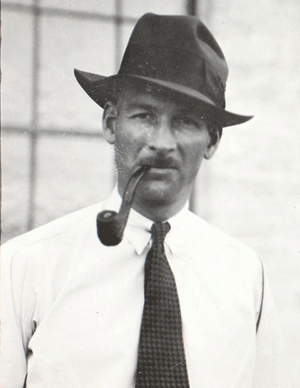 |
He was a precocious aviator. He learned to fly in San Diego in 1910 (this REFERENCE says he learned to fly in 1909). Either way, by 1940 he logged 5,200 flight hours. He flew with Transport pilot certificate T417. He designed, built and flew a glider in 1910 in his mid-teens.
The source says he was "associated with Glenn H. Curtiss Co., San Diego, 1911-12." At that age, for regular teens, this association could have been anything from sweeping floors to maintaining the early Curtiss aircraft. The source is not clear. What is clear is that Waterman designed and built one of the first successful tractor-type aircraft in 1912. He did a little more than sweep floors with Curtiss.
His experience at the University of California must have been a good one, too, because he was appointed as head of The University's Ground School in 1917, the year he graduated. His job description was "Instructor in rigging, structure and care of airplane." In 1917 he published a book, Nomenclature for Aeronautics.
 |
His book was copyrighted as evidenced by the Library of Congress Copyright Office, Catalog of Copyright Entries: Musical compositions, Part 1, Volume 14, Issue 2 from 1917, right. I have no idea why this information appears in the musical compositions volume. Note the misspelling of his middle name. At the time, his slim volume cost $.25 to buy from the Aeronautic Library in New York. I could not find a source where the book might be available today.
By 1919 he was chief engineer at the U.S. Aircraft Corporation. The company at the time was busy with contracts supplying about 50 Curtiss JN-4s under a wartime contract during WWI. After the war and U.S. Aircraft, Waterman barnstormed from 1921-22. I have no information about this activity. If you can help fill in the blanks, please let me KNOW.
Simultaneous with his barnstorming, he formed the Waterman Aircraft Company. It appears that this was his "day job" while barnstorming. His Company operations occupied three locations during its existence. From 1919 -1922 he operated in Venice CA. From 1922-1931 in Ontario CA. From 1931-1939 at Metropolitan Airport, Van Nuys CA. His company ended operations in 1939. From 1939 he built aircraft for his own use. A discourse on all the aircraft designed and built by Waterman is on aerofiles.com at the link (and see below). He produced a half dozen or so original designs, including a conventional low-wing monoplane (see below), tailless models, a flying wing, and a roadable aero-car. He also turned out a few others that were modifications of surplus military aircraft.
 |
This REFERENCE summarizes chronologically Waterman's varied work career through 1940. Besides his Waterman Aircraft Company and barnstorming, he was the general manager of the Los Angeles Metropolitan Airport form 1928-29. The New York Times (NYT) of July 28, 1929 cites an altitude record attempt he made with a "commercial plane," left. No mention was made of the type of airplane, but it could have been a Bach.
He worked for the Bach Aircraft Company from 1931-32 (see the immigration form, below). Another "day job" was with Transcontinental and Western Air (TWA). He flew for that company in 1933. The rest of the 1930s appeared to be taken up with the Waterman Aircraft Company. As WWII approached, he became the coordinator for the Civilian Pilot Training Program at Pasadena Junior College in 1940. One source states, in July 1938, Waterman was hospitalized with a ruptured appendix, and it took him a year to fully recover.
Online U.S. Census, travel and residential data are good for Waterman and his family. From this information we can track his life just about from beginning to end. For example, in 1900 at age five he lived with his parents, a brother and sister in San Diego. In 1910, the Census places him living with his mother as head-of-household and two siblings at 805 Hawthorne St., San Diego. Today this address is an urban spread of stores, businesses and apartment buildings with a Starbucks on the corner. And he was 23 years old on June 30, 1917 when he married Carol Coulter, who was 18.
The 1920 Census cites him at age 25 living at 295 Paloma Avenue, Venice, CA. He lived with his wife Carol, age 20, their infant daughter Jane G. (19 months) and his mother-in-law, Maud D. Coulter. His occupation was listed as "Engineer" working at an "Aircraft Manufacturing Company." That company at the time would be his own, the Waterman Aircraft Company, which he founded at Venice in 1919.
The 1930 U.S. Census places him at age 35 living with his wife, Carol Coulter Waterman (31), and their daughter Jane G. (11) at 460 Mesa Road, in the Pacific Palisades area of Los Angeles, CA. Waterman's mother, Hazel W. (64 and widowed) also lived with them. He owned his home, valued at $12,000. His occupation was cited as "Manager" in the "Airplane" industry. In 1930 he was an "experimental engineer" in charge at the Bach Aircraft Company.
Waterman landed four times at the Grand Central Air Terminal (GCAT). His first landing on Sunday, January 11, 1931 at 1:10PM was in an unidentified Waterman aircraft. He remained on the ground, maybe had lunch in the GCAT restaurant, and departed two hours later. He cited no destination or home base.
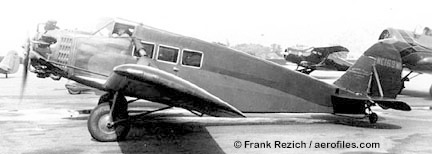 |
His second landing was on Wednesday April 1, 1931 at 4:34PM. He flew an airplane of his own design that he identified as NC169W. It was known as the Waterman W-1 Flex-Wing. The photograph of this airplane, right, is courtesy of aerofiles.com.
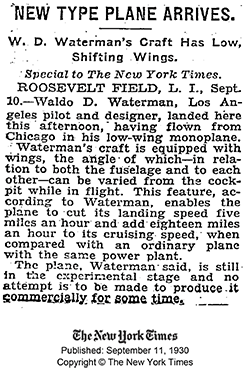 |
The Flex-Wing was unique in that its wings, hinged at the fuselage, allowed the pilot to vary dihedral and angle of attack for better control of the airplane at low speed. The article, left, from The New York Times of September 11, 1930 describes a cross-country flight from Los Angeles Waterman made with a prototype to demonstrate it in New York. Moveable wings were tried earlier in the Golden Age in the name of safety (see this example at the McMullen Photograph & Document Collection), but didn't go into production until much later, in a different way, with swept wing jets for which the goal was speed.
He flew Waterman aircraft to his other two landings, on January 11, April 10, and May 16, 1931, but he did not identify them by registration number except the last, which was 169W (the other two were probably NC169W, also). He also landed once at Clover Field, Santa Monica, CA on Wednesday, May 27, 1931 at 12:10PM. He did identify his aircraft as NC169W in the Santa Monica Register.
In the fall of 1931 he traveled to Mexico. The purpose is not clear from the U.S. Immigration Service list, below, which lists eight other passengers besides Waterman. They arrived from Ensenada aboard NC12206, which was a Bach 3-CT-9K, S/N 22. His flight could have been related to Bach marketing. But November 22nd was a Sunday, so he and his fellow passengers might just have been enjoying the weekend in Ensenada.
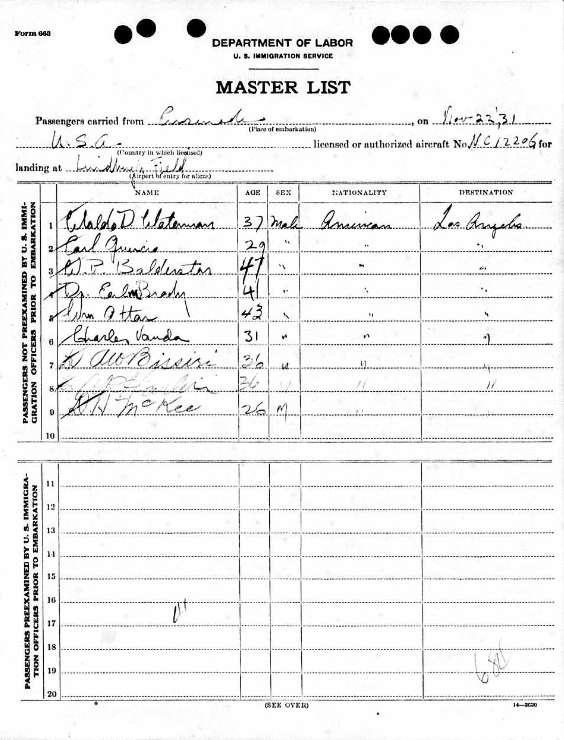 |
In 1932, according to this REFERENCE, 1933, Waterman competed in the Cord Cup Race that was part of the National Air Races that year. He placed 9th flying a Waterman aircraft with a Kinner engine, probably NC169W, which flew with either a 125HP Kinner or a 210HP Kinner C-5.
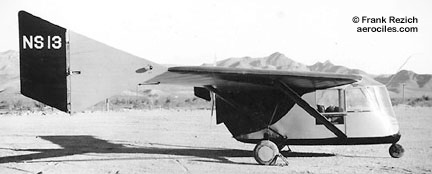 |
There are many articles in the NYT during 1934-1935 regarding Waterman's tailless planes. One, the NYT of August 28, 1934, was a call to aircraft manufacturers by the Department of Commerce (DOC) to respond to a bid to produce an airplane with certain specifications for evaluation in a "safe airplane" competition. Among these specificaitons were that the aircraft be two-passenger, all metal, side-by-side seats, with a cruising range of 300 miles. Other specifications outlined speed and takeoff and landing distances, these being important to the safety of the airplane.
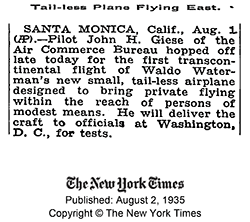 |
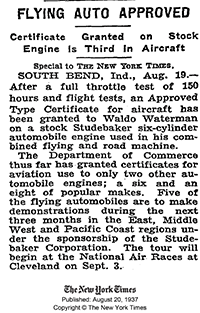 |
The goal of the DOC with this project was to have a plane developed that would be an every man's airplane. One that could be flown safely by people who did not have great piloting skills.
Waterman produced in 1936, with a Works Progress Administration subsidy, the Waterman W-4, NS13. This was purchased by the DOC.The photograph of that airplane, above, courtesy of aerofiles.com. This airplane was flown from San Diego to Washington, DC for evaluation by a low-time DOC pilot. He judged the aircraft safe and easy to fly, was "spin proof" and got 13-14 miles per gallon. Article, right, describes the pickup of the airplane by the DOC pilot, John Giese. Popular Aviation magazine, November, 1935, published a feature article on his W-4. You may download a copy (PDF 265kB) at the link.
In the late 1930s Waterman designed and built flying automobiles. A discourse on the six Arrowbiles constructed by Waterman is at aerofiles.com at the link. Note that the sixth Arrowbile, finally completed in 1957, is now on display at the National Air & Space Museum at the Udvar-Hazy Center.
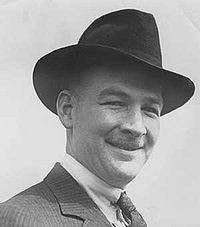 |
In the 1940 U.S. Census, Waterman is living with Carol on Mesa Drive in Los Angeles. Daughter Jane, who would now be 21, was not living with them. His employment was listed as "Proprietor" in the "Aircraft Manufacturing" business.
Through the years Waterman was an Associate Fellow of the Institute of the Aeronautical Sciences, a member of the Professional Pilots Association, the Early Birds of Aviation, Air Industries Association, National Aeronautics Association, and the state and local Chambers of Commerce. He contributed technical papers and articles on aeronautics to magazines and trade journals.
In 1976, the year of his passing, he and Carol lived at 2958 Lawrence St., San Diego, CA. Besides his 1917 book cited above, he must have been working on a book manuscript with a co-author, because it was published posthumously in 1988. See the book cover and bibliographic information at the top of the left sidebar.
---o0o---
SPONSORED LINKS
THIS PAGE UPLOADED: 11/01/15 REVISED: 10/07/16
